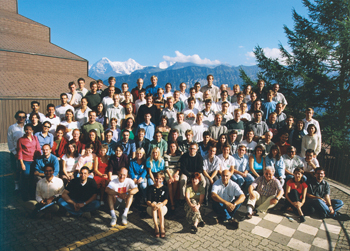
The KEKB Japanese B-factory collider is delivering unprecedented luminosity (a measure of the machine’s electron-positron collision rate) to the international collaboration running the Belle experiment. Since the commissioning of the machine in November 1998, the KEK machine team has solved many difficulties and has recently made major progress – it has achieved the highest luminosity in collider history: 4.49 x 1033 cm-2s-1.
Integrated luminosities (a measure of the collision “dose” administered) are 232 pb-1per day, 1.50 fb-1per week and 4.83 fb-1per month. These are all numbers recorded by the Belle detector. Total data so far collected by Belle had reached 33.1 fb-1by mid-July.
KEKB luminosity has been nearly doubled this year, as seen in the figure above. This was brought about by several machine improvements. First, 1300 out of 1800 m of field-free region of the arcs in the low-energy ring (LER) has been covered with solenoid windings. This suppressed the vertical blow-up of the beam due to the photoelectron cloud up to about 900 mA. The second improvement came from the installation of new movable masks on the moving chamber in the high-energy ring (HER). This replacement, already verified at LER in the previous year, has raised the HER stored current limit HER 580 to 770 mA.
Third, a state-of-the-art setting was achieved in the betatron tunes – very close to the half-integer resonance. The vertical tunes were raised beyond half-integer resonance lines in both rings to gain stability of the orbits as well as a wider high-luminosity area in the tune spaces. The horizontal tunes, especially in LER, were set even closer to the half-integer resonance to gain the dynamic focusing effect of the beam-beam interaction without sacrificing the machine aperture. Other notable improvements are in the orbit control, betatron tune monitor and control, beam-size control, the beam-abort system, the logging system and the injectors.
Though the peak luminosity and integrated luminosity per month are a little higher than those of PEP-II/BaBar at SLAC, Stanford, KEKB needs further improvements to continue to be competitive with its rival in the long run (even assuming the present luminosity of PEP-II). KEKB has significant obstacles in running more than nine months a year due to the periodic inspection of the refrigeration system required by law, expensive summer electricity, a weak cooling system incapable of handling summer heat and so on.
Several improvements are planned during this summer’s shutdown. More solenoid windings are planned in the LER. Currently the electron-cloud effect still looks to be the dominant restriction on the number of bunches circulating in the LER.
Currently, the collision is carried out with four-bucket spacing. A shorter spacing is essential to achieve higher luminosity, because the bunch current is limited in both rings for various reasons.
The replacement of the vacuum chamber is planned at the interaction region (IR), where a tentative limit of the total current is given by the heating of the IR chambers. A new chamber with a taller aperture will be installed in the HER downstream of the IR, as well as additional cooling systems in LER upstream.
Current movable masks of absorber type are going to be replaced with spoiler-type masks to reduce damage by beam loss.
Damage to the movable masks has been a serious obstacle in beam operation. A solution will be thinner masks to reduce significant heating damage.
Other related improvements planned for this summer are a mask protection system with the beam-loss monitor and the addition of a few more radiofrequency cavities to give a margin for high-current operation.
The Belle detector at the Japanese KEKB is studying the decays of B-mesons (particles containing the fifth “b” quark), in particular the delicate violation of charge-parity (CP) symmetry (see above).
The impact of the machine’s performance on this measurement was eagerly awaited.
CP-violation parameter
In time for the summer conference season, both of the big experiments measuring the charge-parity (CP) asymmetry in the decays of B-mesons reported impressive results.
The BaBar experiment at the PEP-II electron-positron collider at SLAC, Stanford, based on a sample of 32 million B pairs, reported a value for the sin2ß CP-violation parameter of 0.59 ± 0.14. The BELLE experiment at the KEKB electron-positron collider at the Japanese KEK laboratory, with 31.3 million B pairs, measures the parameter as 0.99 ± 0.14 ± 0.06.
These are the most precise measurements of this parameter so far. For statistical sticklers, the results are now clearly non-zero – physicists can say with confidence that CP violation happens in B decays. Using earlier measurements, the world average becomes 0.79 ± 0.12 compared to the theoretically predicted value of 0.70 ± 0.12.





